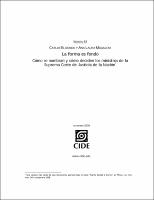| dc.creator | Magaloni Kerpel, Ana Laura |
| dc.creator | Elizondo Mayer-Serra, Carlos |
| dc.date.issued | 2009 |
| dc.identifier | 98470.pdf |
| dc.identifier.uri | http://hdl.handle.net/11651/1306 |
| dc.description.abstract | Los ministros no han logrado hacer de la Suprema Corte de Justicia un órgano capaz de articular el sentido y alcance de los preceptos constitucionales frente a la sociedad. No sorprende, por ello, que las encuestas muestren una baja confianza en nuestra Corte. Este trabajo pone atención en algunas cuestiones formales que impactan en el desempeño y legitimidad de nuestra Corte. El punto de partida del análisis es que la forma importa. Por un lado, las reglas de elección y duración del encargo tienen un efecto sobre quiénes llegan a ministros y con qué expectativas. Por el otro, el método por el cual los once ministros llegan a su decisión afecta el fondo de las sentencias. El presente documento se divide en tres secciones: la primera estudia qué dicen los datos respecto a la confianza en la Suprema Corte. La segunda analiza cómo la forma de elegir ministros afecta en quiénes llegan a serlo y con qué objetivos profesionales. Finalmente, en la tercera sección, se estudiará cómo los aspectos formales del proceso de decisión del Pleno de la Suprema Corte afectan las sentencias, tanto formal como sustantivamente, y por ende su legitimidad. |
| dc.description.abstract | Justices have not succeeded in transforming the Supreme Court into a body capable of articulating the meaning and scope of constitutional precepts to Mexican society. Not surprisingly, therefore, opinion polls have shown low confidence in our Court. This document brings attention to some formal issues that impact the performance and legitimacy of our Court. The starting point of this analysis is that formal questions matter. On one hand, the rules of election and the time in office affect who takes a seat in the Court and with what expectations. On the other hand, the method by which the eleven justices reach a decision affects the contents of their ruling. This work is divided into three sections: the first considers what the data from opinion polls say about confidence in the Supreme Court. The second will consider how the way in which Justices are elected affects who makes it to the Court as Justice and with what kind of professional goals. Finally, in the third section, we will study how formal aspects of the decision-making process of the Plenary of the Supreme Court affect its rulings, both formal and substantively, and, therefore, the legitimacy of the Court as a whole. |
| dc.format | application/PDF |
| dc.language.iso | spa |
| dc.publisher | Centro de Investigación y Docencia Económicas, División de Estudios Jurídicos |
| dc.relation.ispartofseries | Documento de trabajo (Centro de Investigación y Docencia Económicas). División de Estudios Jurídicos; 43 |
| dc.rights | El Centro de Investigación y Docencia Económicas A.C. CIDE autoriza a poner en acceso abierto de conformidad con las licencias CREATIVE COMMONS, aprobadas por el Consejo Académico Administrativo del CIDE, las cuales establecen los parámetros de difusión de las obras con fines no comerciales. Lo anterior sin perjuicio de los derechos morales que corresponden a los autores. |
| dc.subject.lcsh | México. Suprema Corte de Justicia de la Nación. |
| dc.subject.lcsh | Judges -- Selection and appointment -- Mexico. |
| dc.title | La forma es fondo: cómo se nombran y cómo deciden los ministros de la Suprema Corte de Justicia de la Nación |
| dc.type | Documento de trabajo |
| dc.accessrights | Acceso abierto |
| dc.recordIdentifier | 000098470 |
| dc.rights.license | Creative Commons Reconocimiento-NoComercial-SinObraDerivada 4.0 International CC BY-NC-ND |


